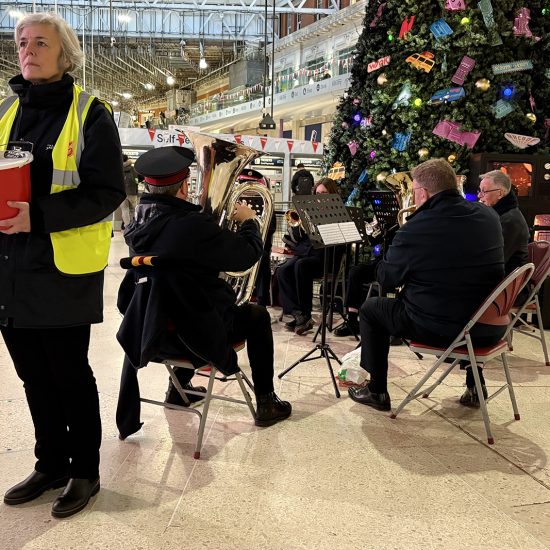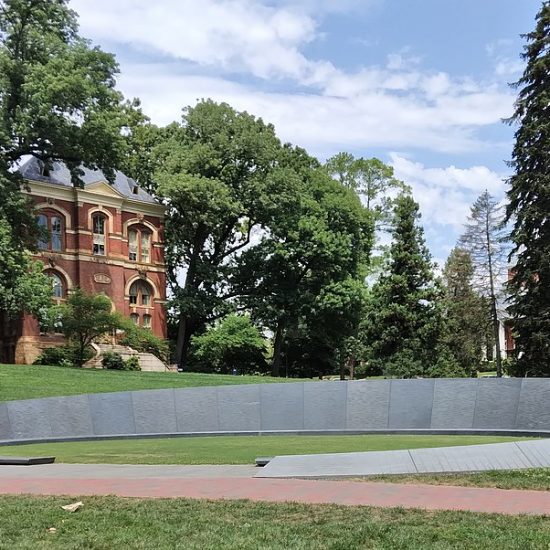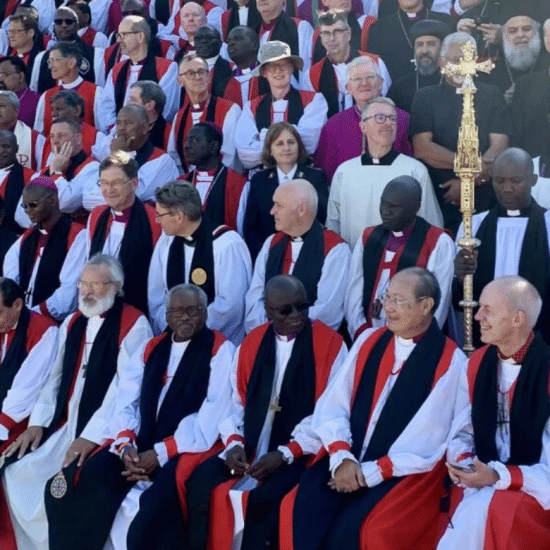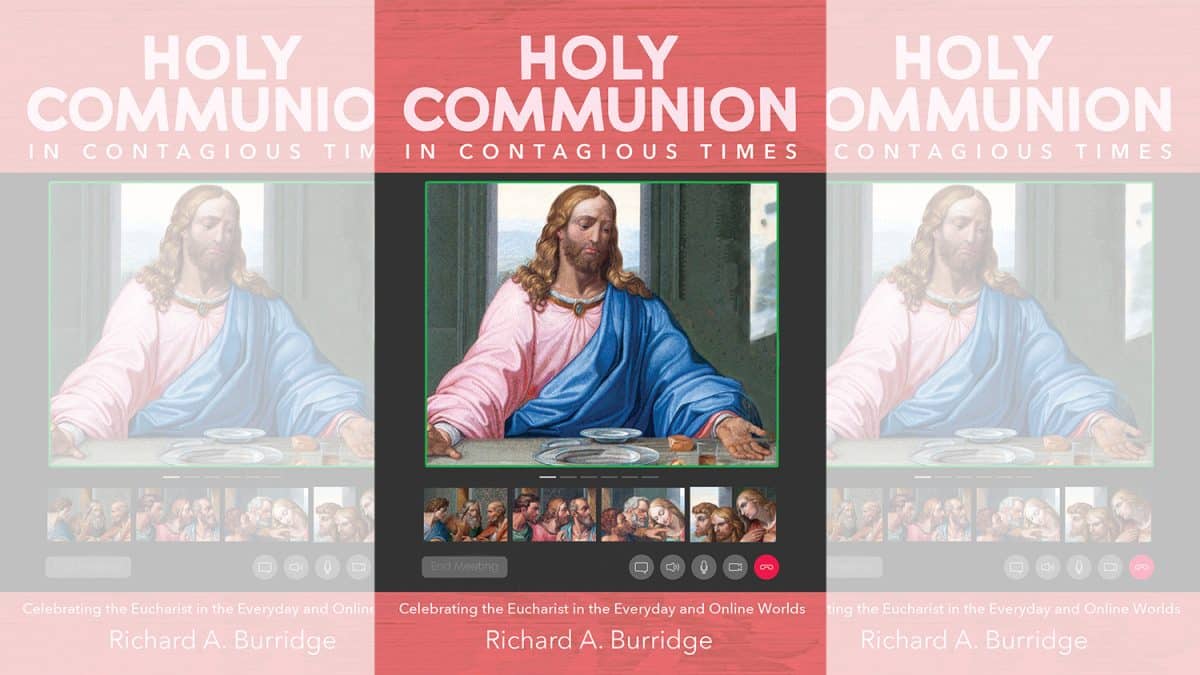
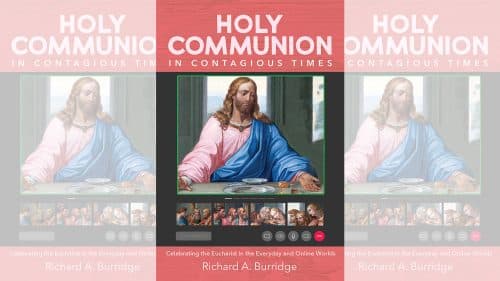
HOLY COMMUNION IN CONTAGIOUS TIMES: Celebrating the Eucharist in the Everyday and Online Worlds. By Richard A. Burridge. Eugene, OR: Cascade Books, 2022. Xii + 282 pages.
In March of 2020, the COVID-19 virus locked down the world. One week we were doing church like normal, and a week later everything was turned upside down. As a pastor, I was confronted with challenges never faced before in my many years of ministry. COVID posed significant problems for religious communities that traditionally gather in person. After all most of us who served churches didn’t think of ourselves as TV evangelists. Now we found ourselves moving church life online so that we could maintain some form of connection with the people who make our faith communities. Some communities turned to Zoom for worship. Others turned to YouTube or Facebook so we could live stream some form of worship. The church I served at the time, used a smartphone to broadcast an abbreviated service using Facebook Live, featuring me as the preacher, Rick at the Table, and Pat at the organ and piano (oh, and I did the singing from the pulpit). We tried to make things as close to normal as possible for our people who were at home, and who would remain that way for most of the following year. Even after we opened up in June of 2020, only a few of our people ventured out (and most were family to those leading the service).

Robert D. Cornwall
One element of worship quickly became a point of contention. Can we offer communion/Eucharist digitally? Is it a valid sacrament? This is an important question for communities, like mine, that put the Lord’s Supper at the center of our worship experience. Because our beliefs on these matters differ, different perspectives were offered. The truth is, none of us has ended up in the same place as before.
For my part, I’m ordained in the Christian Church (Disciples of Christ). The Lord’s Supper is central to who we are as a people. We practice weekly communion. Our denominational logo is a red chalice with the St. Andrew’s cross superimposed on it. Fortunately, while many colleagues were trying to figure out what to do about the Eucharist, our tradition doesn’t require ordained clergy to preside (traditionally it has been an elder who is a layperson, though in recent decades clergy have presided along with the lay elders). In our case, we included communion in our service, offering the words of institution and prayers, and inviting those at home to make use of their own elements. I assume that what was true for us was true for most in my denomination. However, not every tradition has the same perspective on things. Thus, they faced the need to address the situation. So multiple conversations emerged, with some clergy and churches making allowances for an unforeseen situation that was out of their control. While not every community resolved the questions, it did raise conversations about the meaning and purpose of corporate worship and the sacraments. Central to these conversations is the question of whether God is present in the virtual/digital world?
I must confess that I much prefer meeting in person. There is something about in-person worship that for me can’t be replicated. You can deliver a message online, but corporate singing of hymns and songs is not the same as in person. As for the sacrament of communion, there is something to be said about the physical nature of being together as a body. But what do we do during “Contagious Times?” As the title of Richard Burridge’s recent book suggests, we have to figure out how best to continue practicing our faith when faced with a contagion that kills. Burridge is a priest in the Church of England, a biblical scholar, and a former dean of King’s College, London. Shortly before the COVID pandemic hit Burridge had retired from his position at King’s College and had moved north in England. He had been seeking ways to experience Anglican worship, including the Eucharist, when COVID forced everyone to lockdown, including the churches. This led to conversations within the Church of England and other churches about what to do, especially since clergy in that Church were banned from entering their church buildings. At least they were blocked from holding services from those buildings, even if they were held online (something I didn’t face). Burridge got involved in the conversation, offering his expertise, by writing a paper on the topic of online worship for the Church of England bishops. That paper led to the production of this rather lengthy book, which deals with ways in which the church attempted to respond to the crisis and Burridge’s reflections on these attempted responses.
The title of the book – Holy Communion in Contagious Times draws on a rubric found in the 1662 Book of Common Prayer. The book itself is both a scholarly response and a personal reflection since Burridge draws on his own experiences watching, participating in, and leading online communion services. He focuses on Anglican experiences and expectations, but his conversation partners include others from outside his communion, including Baptists. Among the Baptists, he engages with is Paul Fiddes, a retired professor of theology at Oxford University. This engagement is very helpful. For my purposes, I was pleased that he acknowledged the perspectives of other denominations, including my own, including a paragraph from the guideline for Disciples ordination services, where it is pointed out that while traditionally elders from within the congregation presided, “the right and responsibility to preside at the Table is increasingly a role shared by elders and ministers” (p. 76).
The question that emerged in the course of the pandemic has to do with the place of communion in the worship of the church. This is an especially important question in a faith community where communion is practiced not just weekly (as is true for my denomination), but often daily. The Church of England, from its founding, responded to the Medieval Catholic practice of solitary Eucharists by requiring that at least one other person besides the priest celebrating the Eucharist was in attendance and able to partake of the elements. So how do you do this when no one is allowed to be present for the service? As we learn from Burridge’s account, the Church authorities made it clear that there should be no remote consecrations of the Eucharist. Thus, online communion was forbidden. This book is rooted in Burridge’s response to the bishop’s determination that something he had been experimenting with was unlawful (at least in his church).
As the church sought to respond to the ongoing pandemic, it offered several possibilities. As we learn in the book some suggested that the people should engage in a eucharistic fast. The word was this, just abstain. The question quickly emerged, but for how long? Others suggested the practice of spiritual communion. In this solution, one could participate in some form of worship, perhaps observing someone consecrating the eucharist, and contemplating the elements, but not partaking. This became the go-to solution but is watching a priest consecrate the elements without sharing in something tangible yourself enough? In other words, are there other options that allow for people to participate remotely?
For those interested in these questions—remember the focus here in the book is on the Church of England and other Episcopal communions—this is a most interesting book. Even if your tradition is more “permissive” when it comes to such things, Burridge invites us to re-envision the role of the Eucharist and the clergy in the way in which we worship. Burridge divides the book into two parts. Part One focuses on “Holy Communion in ‘Contagious Times’ in the Everyday World.” Here he works through seven proposed solutions, starting with the Eucharistic Fast and moving through other possibilities including lay presidency (Anglicans reject it though my tradition embraces it) to Drive-in Churches and Drive-Thru Communions while using rubrics (rules/guidelines) for homebound communions. None of these solutions prove truly effective, but some are more helpful than others.
In Part 2, Burridge focuses on “Holy Communion and Technology in the Digital Online World.” Here is where things get really interesting because he addresses the concerns of many, especially those who believe that the eucharistic elements need to be consecrated by a duly ordained figure. He offers an introduction to several possibilities in chapters 10 and 11. Then in chapter 12, he engages with a particular form of digital gathering. That would be Second Life, which is a format that has been around for some time, and I think may have lost some of its earlier popularity. Even if that is the case, it offers us a window into the possibilities of digital gatherings. Burridge focuses on the Anglican Cathedral in Second Life. He raises the question of whether avatars can take communion. As he does this, he raised the question of whether God is present in the virtual world? This is a good question that deserves our attention, even outside the question of a pandemic. How might God be present digitally?
From there Burridge moves toward pathways that were more likely to be taken during the pandemic. So, in chapter 13 he offers background on the concept of the celebrant’s intention. Here the question is, how might the celebrant intend for the prayers and words of consecration be extended outward through digital means? Here he draws on the experience of large in-person eucharistic services in which the celebrant cannot see or touch all the elements being distributed. Are these elements properly consecrated? The answer has always been, yes. With this question in mind, chapters 14 and 15 explore two more proposals. One has to do with broadcasts and live streaming (as my congregation did) where anyone who wishes to participate can be present. The other has to do with narrowcasts. The latter is the use of more participatory platforms such as Zoom. This seems to be Burridge’s preferred solution since it allows for the celebrant’s intention to be fully realized since the celebrant can see the elements on the screen and intentionally speak to them (as long as everyone is using their video and can make their elements visual to the priest).
As I read Burridge’s book, recognizing that my tradition has different rules when it comes to how the Lord’s Supper is celebrated and my personal belief that the Table should be open to all, I was more interested in the questions raised than the solutions proffered. Though the possible solutions are important, from an ecumenical perspective this conversation raises important questions about who can preside and what that means for the life of the church. Additionally, if as many believe, churches will be turning more and more to online platforms what does that mean for communities that have placed the Lord’s Supper/Eucharist at the center of their worship life? One of the values that Burridge brings to the conversation is his background as a biblical scholar. He brings a certain wealth of expertise to the conversation that enlightens us as to the foundational principles that undergird our celebrations. He also brings a certain openness to new ways of being the church that allows him to envision other possibilities. While, hopefully, this time of contagion will eventually end, and most of our congregations have returned to some form of “normalcy,” such that the lockdowns are over and we can gather in person (even if traditional ways of partaking of the elements are problematic), this should prove to be an important contributor to a conversation that will continue once the contagion subsides. If, as many predict, we’ll still be gathering in the digital and online worlds for the foreseeable future, how will we celebrate Holy Communion? That is the question that faces the church as we continue moving through the twenty-first century. As the former Archbishop of Canterbury, Rowan Williams, suggests in his endorsement: “No one will finish this book without a deeply enhanced sense of the meaning of the eucharist.” Indeed!
This review originally appeared on BobCornwall.com.
Robert D. Cornwall is an ordained minister in the Christian Church (Disciples of Christ). Now retired from his ministry at Central Woodward Christian Church (Disciples of Christ) of Troy, Michigan, he serves as Minister-at-Large in Troy. He holds a Ph.D. in Historical Theology from Fuller Theological Seminary and is the author of numerous books including his latest books: Called to Bless: Finding Hope by Reclaiming Our Spiritual Roots (Cascade Books, 2021) and Unfettered Spirit: Spiritual Gifts for the New Great Awakening, 2nd Edition, (Energion Publications, 2021). His blog Ponderings on a Faith Journey can be found at www.bobcornwall.com.

